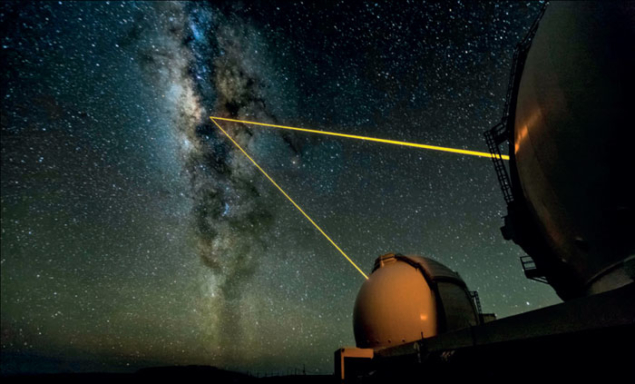
Image credit: Ethan Tweedie Photography.
Astronomers have been tracking the motion of stars at the very centre of the Galaxy for the past 20 years. One star in particular has attracted a great deal of attention by completing a full orbit round the supermassive black hole at the centre with a period of about 16 years. Now a team using the two Keck telescopes in Hawaii has detected another much fainter star with an even shorter period of only 11.5 years. This second star will help test Albert Einstein’s theory of general relativity in the strong gravitational field of the back hole.
The Sun is located at the periphery of a disc-shaped spiral galaxy, commonly known as the Galaxy. Seen from Earth, the lights from thousands of millions of stars in this galaxy form a bright stripe across the night sky. This is the Milky Way. However, most of the stars remain hidden behind an inhomogeneous web of gas and dust, forming the interstellar medium. While this absorbing material obscures the view of the galactic centre in visible light, at infrared wavelengths, dust becomes much more transparent. The advent of infrared cameras in the 1990s therefore allowed the detection of the Galaxy’s most centrally located stars for the first time.
Europeans and Americans competed to follow the motion of these stars with the goal of ascertaining the existence of a supermassive black hole in the Galaxy. The Europeans started in 1992 by using the New Technology Telescope and then the Very Large Telescope of the European Southern Observatory (ESO) in Chile, and since 1995 the Americans have used the Keck Observatory in Hawaii. Both groups used a star, S0-2, that orbits the radio source Sagittarius A* in 15.9 years to derive the mass and the distance of the black hole coinciding with this source. Around four years ago, they obtained a result of about 4 million solar masses located some 27,000 light-years away.
Now a group of astronomers, led by Leo Meyer and Andrea Ghez from the University of California, Los Angeles, has found a second star that is even closer to the supermassive black hole, with a period of only 11.5 years. Being 16 times fainter than S0-2, this new source, S0-102, was difficult to detect by the twin Keck telescopes in the crowded central region of the Galaxy. It is mainly thanks to adaptive optics that this star could be identified and tracked. Adaptive optics, first employed in 2004 at the Keck Observatory, is a technique used to correct in real time the deformation of the image induced by turbulence in the atmosphere. The wave-front deformation is measured by observing a bright star or an artificial “guide star”, generated in the upper atmosphere by a powerful sodium laser. The correction is implemented by changing the inclination and the shape of the deformable secondary mirror on time scales of a few milliseconds.
The detection of a second star orbiting closely the supermassive black hole of the Galaxy will enable tests of general relativity in a gravitational potential that is two orders of magnitude stronger than at the surface of the Sun. The effect of curved space–time manifests itself by a deviation from the Keplerian orbit of the stars and a relativistic red shift of their emission. The gravitational red shift could become measurable at the next closest approach to the black hole, in 2018 for S0-2 and three years later for S0-102. The deformation of the elliptical orbits induced by curved space–time will be more difficult to identify and might await the next generation of 30-m class telescopes. The presence of the second star will anyway be instrumental in breaking the degeneracy inherent in the measurement of curved space–time with a single star.







